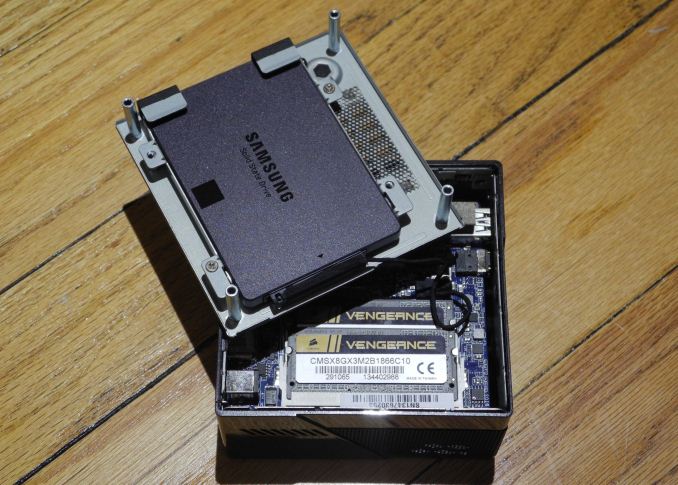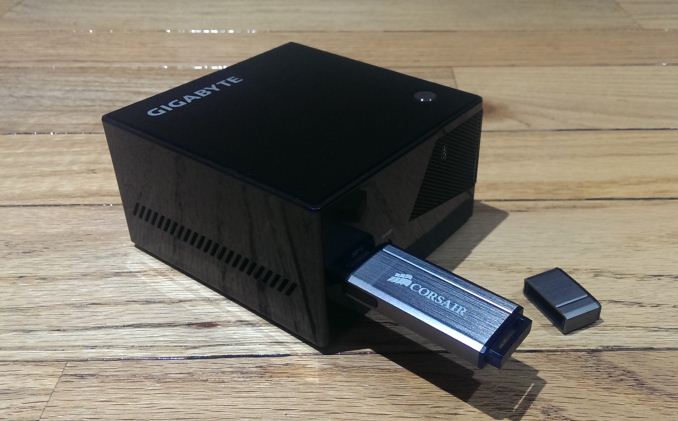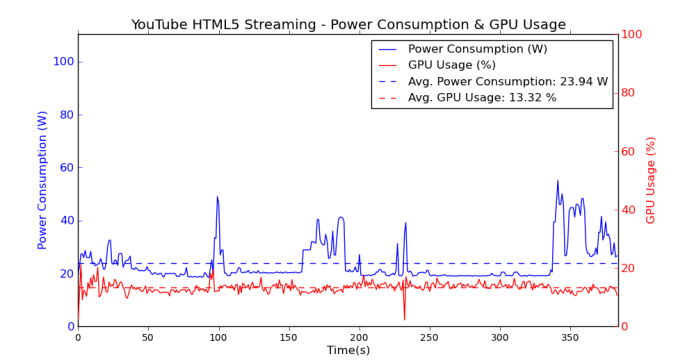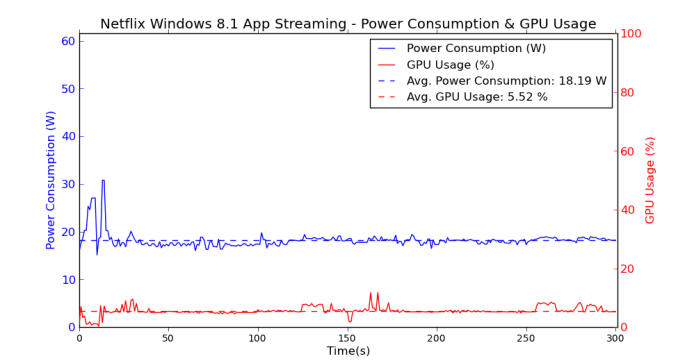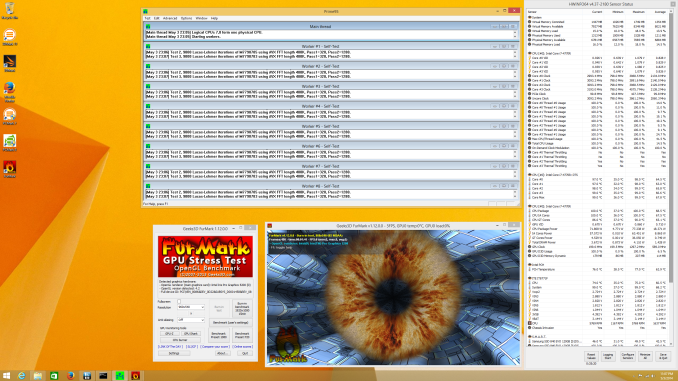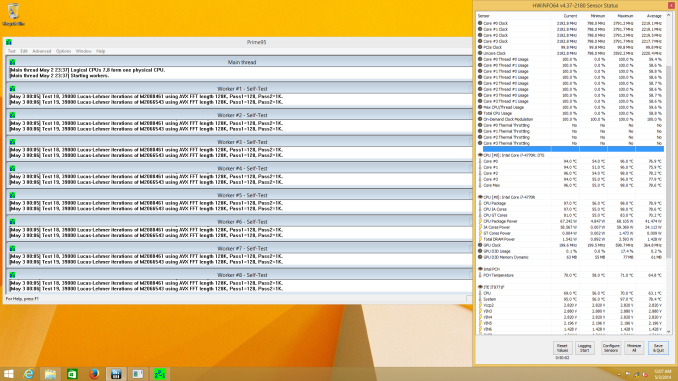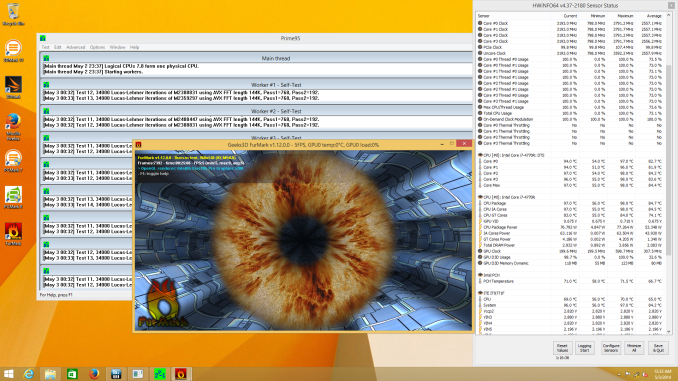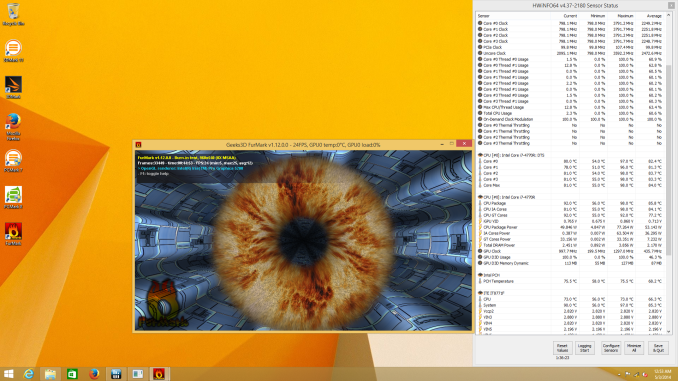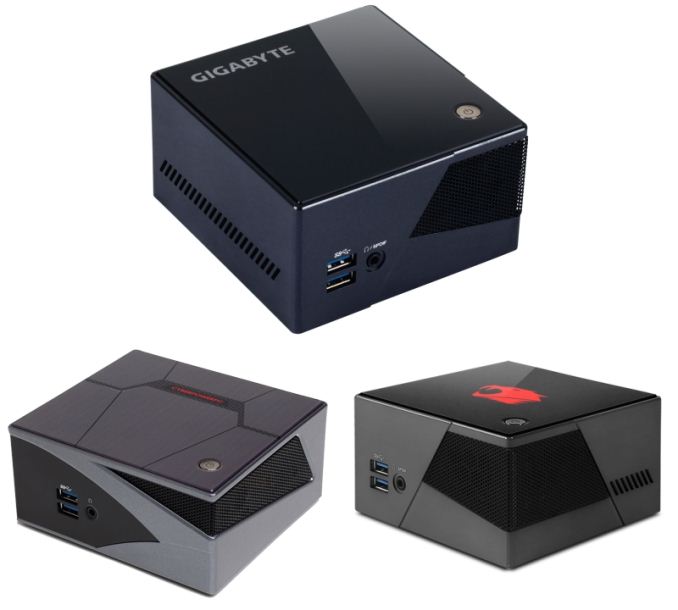
Original Link: https://www.anandtech.com/show/8175/gigabyte-brix-pro-a-second-look-at-the-intel-i74770r-with-iris-pro-hd-5200
GIGABYTE BRIX Pro: A Second Look at the Intel i7-4770R with Iris Pro HD 5200
by Ganesh T S on June 14, 2014 5:00 PM EST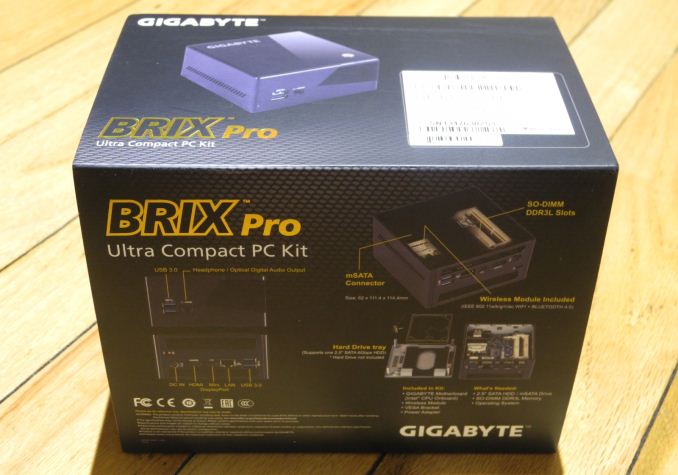
Recap
Earlier this year, we had our first look at the GIGABYTE BRIX Pro, along with a note about further benchmarks to follow. It was our first look at the Intel Core i7-4770R, a Crystal Well part with 128 MB of eDRAM built into the package. The part was aimed squarely at making integrated graphics competetive with low-end discrete GPUs. As a direct result of this, PC manufacturers could make compact gaming units. The BRIX Pro was even distributed at the Steam Developers Conference as a Steam Machine.
In our second look at the BRIX Pro, we changed the memory and storage subsystem to better reflect the expected use case. The table below provides the components utilized for the build along with pricing information.
| Gigabyte GB-BXi7-4770R (2) Build Components | ||
| Component | Price | |
| Chassis / CPU / Motherboard / PSU | GB-BXi7-4770R | $649 |
| Memory | Corsair Vengeance CMSX8GX3M2B1866C10 2x4 GB Kit | $95 |
| SSD | Samsung SSD 840 EVO 120 GB | $90 |
|
|
||
| Total | $834 | |
Readers may remember that the first part of our BRIX Pro review used Crucial DRAM modules and an Intel mSATA drive. Gamers usually go for higher memory speeds and SATA-based 2.5" drives are usually much cheaper compared to mSATA drives for the same capacity. The Corsair memory modules are rated for 1866 MHz (compared to Crucial's 1600 MHz) and, while the capacity of the 840 EVO (120 GB) is lower than that of the Intel mSATA drive (180 GB) used earlier, it is fine for applications where games and other heavy content are stored on an external drive.
Benchmark numbers change with the new configuration and so we reran our evaluation suite. The first two sections will deal with the updated benchmark numbers. Following this, we have a section presenting our gaming benchmarks. Recently, we have started evaluating the wireless networking and storage subsystem for mini PCs and results for the BRIX Pro are presented in a separate section. We touch briefly upon the HTPC aspects before discussing the thermal aspects. However, prior to all that, we have a table presenting the details of various systems that are compared against the BRIX Pro in this review.
| Comparative PC Configurations | ||
| Aspect | GIGABYTE GB-BXi7-4770R (2) | |
| CPU | Intel Core i7-4770R | Intel Core i7-3720QM |
| GPU | Intel Iris Pro Graphics 5200 | Intel HD Graphisc 4000 |
| RAM |
Corsair Vengeance CMSX8GX3M2B1866C10 10-10-10-32 @ 1866 MHz 2x4 GB |
Super Talent W1333SB4GH 9-9-9-24 @ 1333 MHz 2x 4GB |
| Storage |
Samsung SSD 840 EVO (120 GB, 2.5in SATA 6Gb/s, 19nm, TLC) |
Intel® SSD 330 Series (60 GB, SATA 6Gb/s, 25nm, MLC) |
| Wi-Fi |
Realtek 8821AE Wireless LAN 802.11ac (1x1 802.11ac - 433 Mbps) |
N/A |
| Price (in USD, when built) | $829 | $1300 |
Performance Metrics - I
The BRIX Pro was evaluated using our standard test suite for low power desktops / industrial PCs. We have recently revamped our benchmark suite (after the publication of the Intel D54250WYK NUC review). We reran some of the new benchmarks on the original configuration also, but some of them couldn't be run on loaner samples. Therefore, the list of PCs in each graph might not be the same.
Futuremark PCMark 8
This is one of the new tests in our test suite. PCMark 8 provides various usage scenarios (home, creative and work) and offers ways to benchmark both baseline (CPU-only) as well as OpenCL accelerated (CPU + GPU) performance. We benchmarked select PCs for the OpenCL accelerated performance in all three usage scenarios.
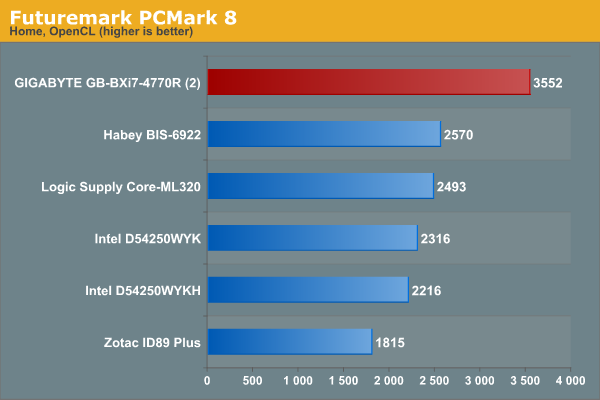
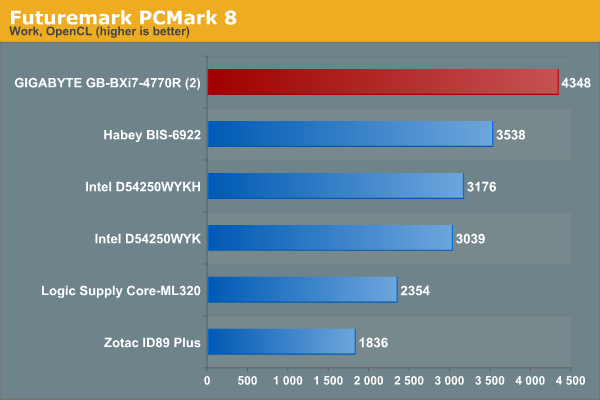
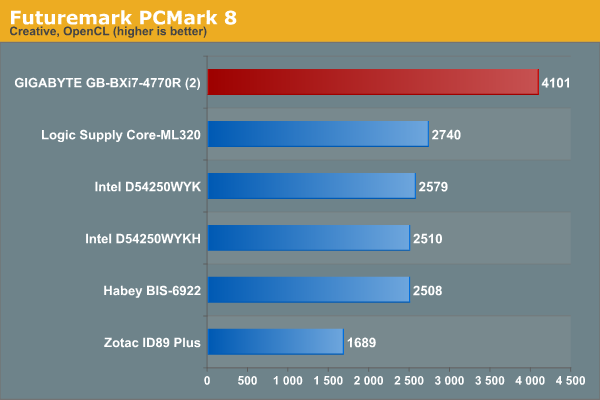
Miscellaneous Futuremark Benchmarks
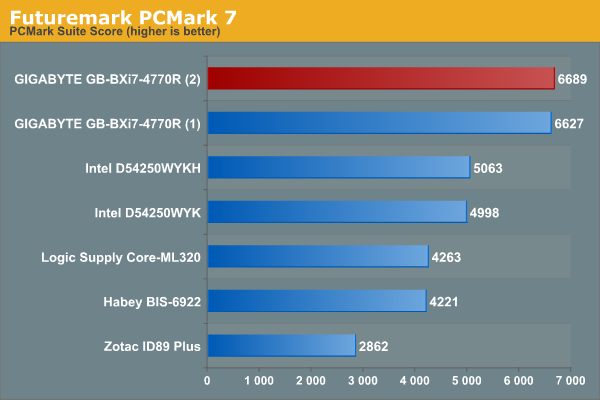
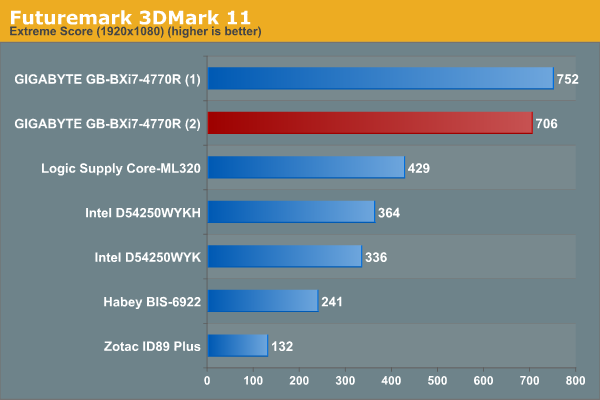
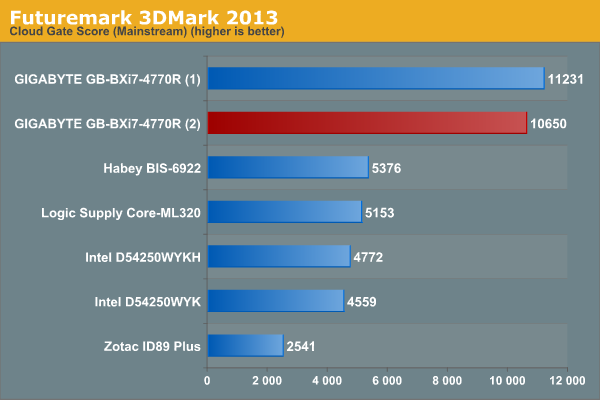
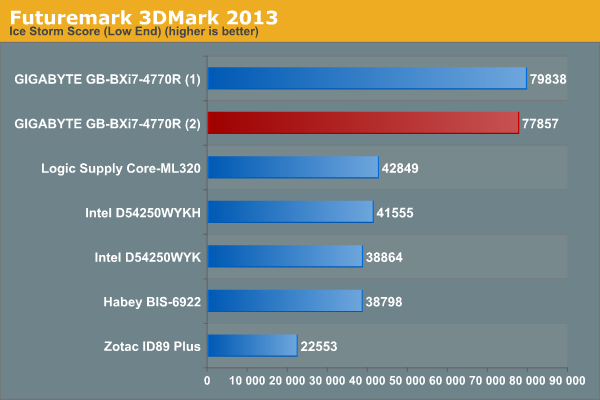
3D Rendering - CINEBENCH R15
We have moved on from R11.5 to R15 for 3D rendering evaluation. CINEBENCH R15 provides three benchmark modes - OpenGL, single threaded and multi-threaded. Evaluation of select PCs in all three modes provided us the following results.
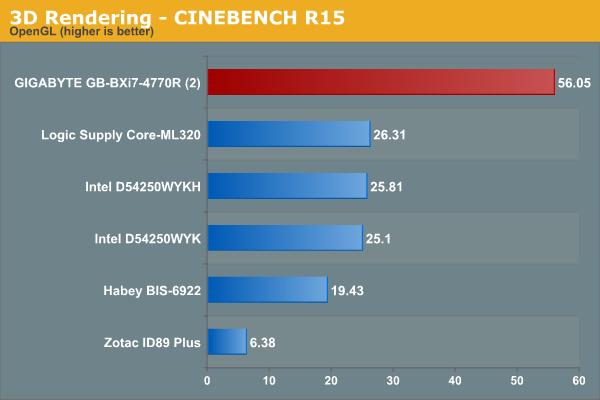
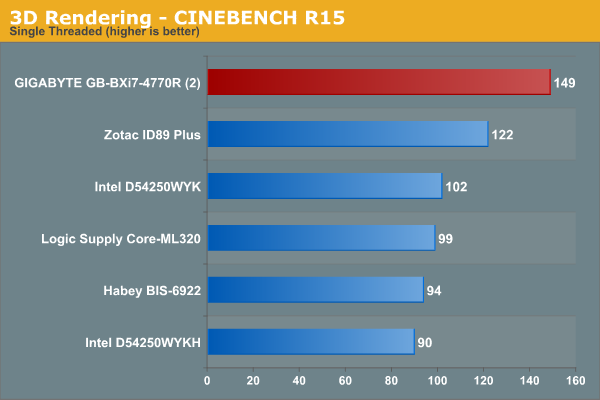
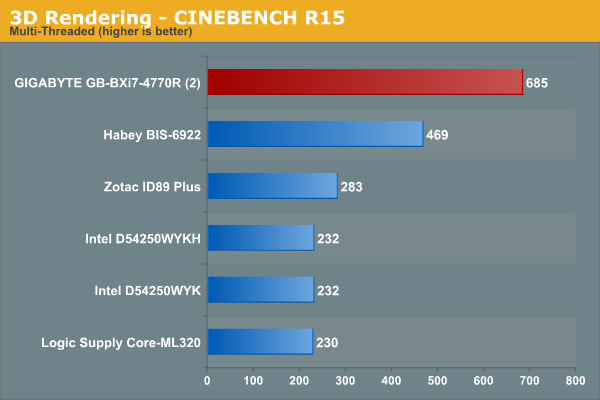
Performance Metrics - II
In this section, we mainly look at benchmark modes in programs used on a day-to-day basis, i.e, application performance and not synthetic workloads.
x264 Benchmark
First off, we have some video encoding benchmarks courtesy of x264 HD Benchmark v5.0.
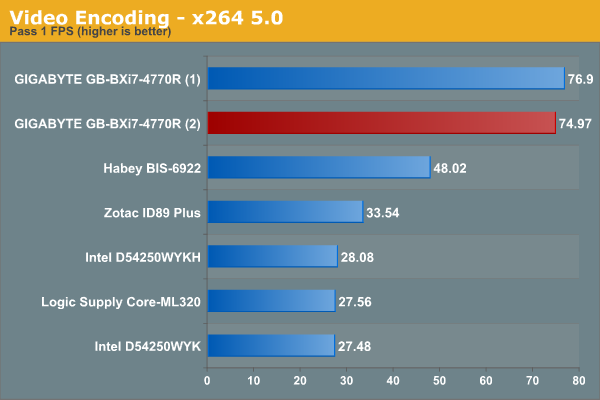
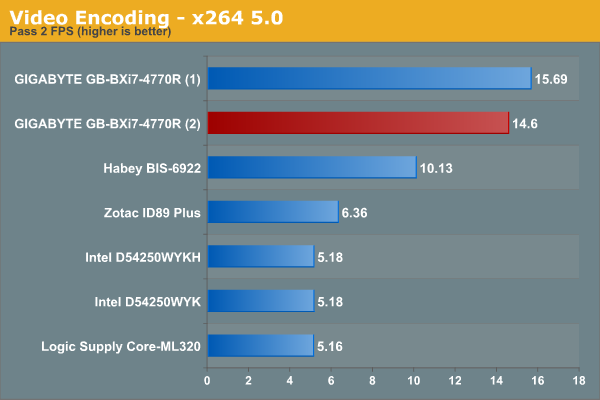
7-Zip
7-Zip is a very effective and efficient compression program, often beating out OpenCL accelerated commercial programs in benchmarks even while using just the CPU power. 7-Zip has a benchmarking program that provides tons of details regarding the underlying CPU's efficiency. In this subsection, we are interested in the compression and decompression MIPS ratings when utilizing all the available threads.
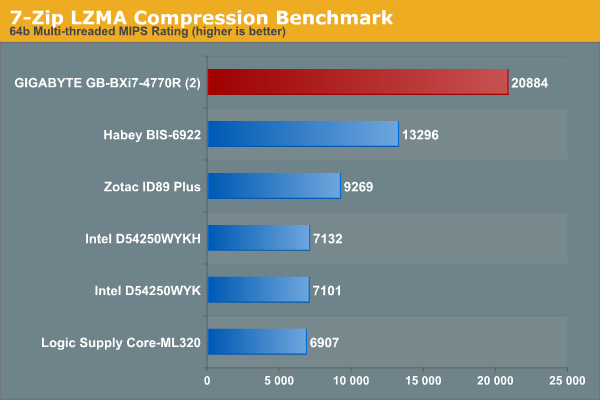
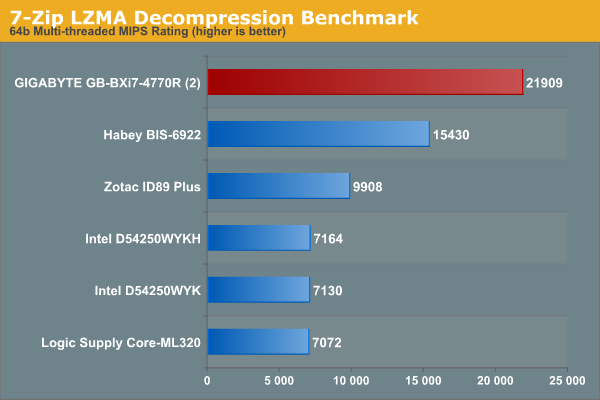
TrueCrypt
As businesses (and even home consumers) become more security conscious, the importance of encryption can't be overstated. CPUs supporting the AES-NI instruction for accelerating the encryption and decryption processes have, till now, been the higher end SKUs. However, with Bay Trail, even the lowly Atom series has gained support for AES-NI. The i7-4770R, being the flagship Crystal Well part for Haswell, hasn't been left behind. It does have AES-NU support and TrueCrypt, a popular open-source disk encryption program which can take advantage of the AES-NI capabilities. The TrueCrypt internal benchmark provides some interesting cryptography-related numbers to ponder. In the graph below, we can get an idea of how fast a TrueCrypt volume would behave in the BRIX Pro and how it would compare with other select PCs. This is a purely CPU feature / clock speed based test.
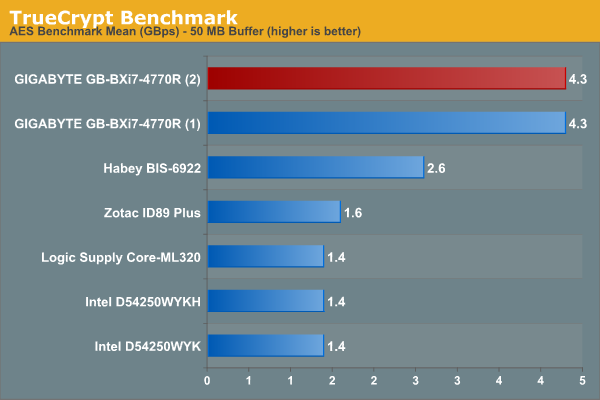
Agisoft Photoscan
Agisoft PhotoScan is a commercial program that converts 2D images into 3D point maps, meshes and textures. The program designers sent us a command line version in order to evaluate the efficiency of various systems that go under our review scanner. The command line version has two benchmark modes, one using the CPU and the other using both the CPU and GPU (via OpenCL). The benchmark takes around 50 photographs and does four stages of computation:
- Stage 1: Align Photographs
- Stage 2: Build Point Cloud (capable of OpenCL acceleration)
- Stage 3: Build Mesh
- Stage 4: Build Textures
We record the time taken for each stage. Since various elements of the software are single threaded, others multithreaded, and some use GPUs, it is interesting to record the effects of CPU generations, speeds, number of cores, DRAM parameters and the GPU using this software.
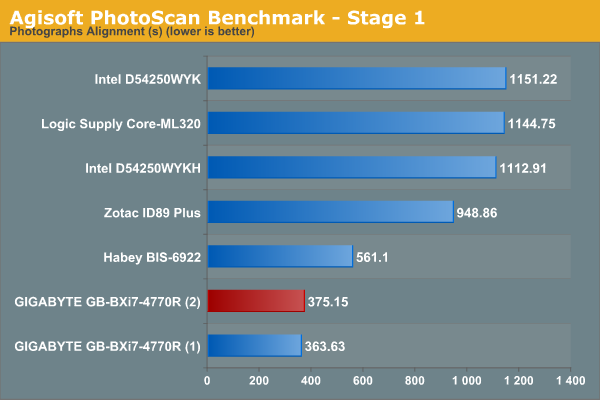
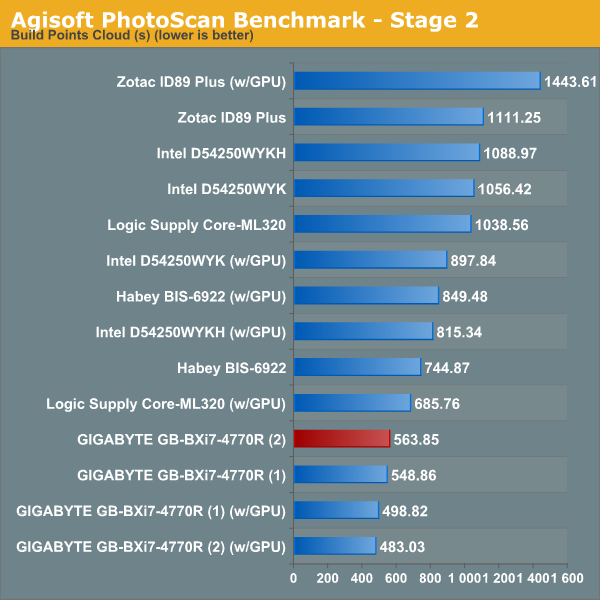
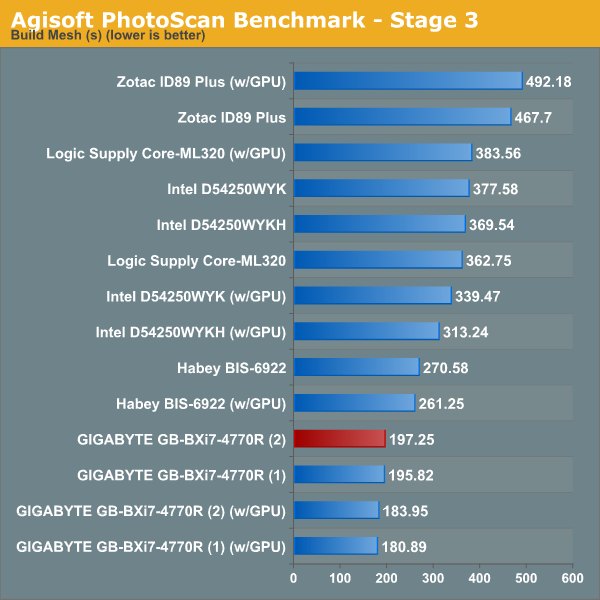
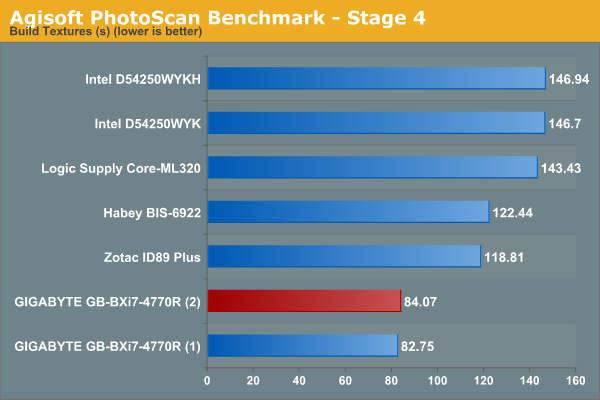
Dolphin Emulator
Wrapping up our application benchmark numbers is the Dolphin Emulator benchmark mode results.
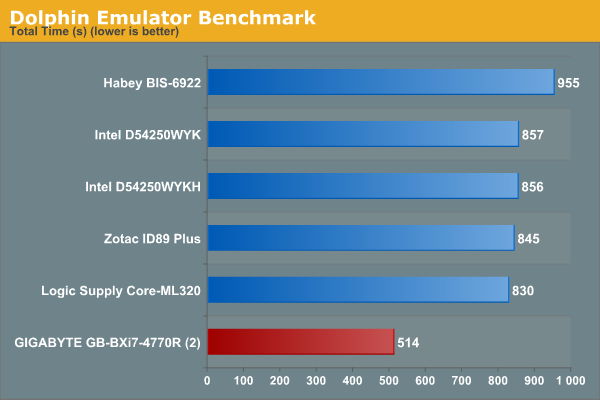
Gaming Performance Evaluation
The gaming credentials of the BRIX Pro received a huge marketing boost when it was distributed as a 'Steam Machine' at the Steam Developers Conference earlier this year. Based on paper specifications alone, the BRIX Pro should be able to perform much better than any other previous Intel IGP. For the purpose of benchmarking, we chose five different games (Company of Heroes 2, Sleeping Dogs, Tomb Raider, Bioshock Infinite and DiRT Showdown) at three different quality levels. For today's review, we have numbers from the BRIX Pro's current configuration, the Intel D54250WYKH NUC (HD 5000) and the BRIX Pro with the configuration from the earlier review. In addition, we also dusted off a old gaming mini-PC, the ASRock Vision 3D 252B and processed our gaming benchmarks on that unit's GT 540M using the latest NVIDIA drivers.
Corsair Flash Voyager GS - A Portable Steam Drive
As someone focusing on HTPCs and multimedia aspects, I rarely get to process gaming benchmarks, even while evaluating GPUs. One of the aspects that I feared was spending lot of time in installing the same games again and again on different PCs under the review scanner. The solution was to go the Steam route. Unfortunately, Steam also likes to keep the game files updated. A quick online search revealed that Steam could make use of an external drive for storing the game executables and downloadable content.
While searching for the ideal external drive to use for this purpose, Corsair came forward with their Flash Voyager GS USB 3.0 drive. The 128 GB capacity was more than enough for all the games that I planned to use for benchmarking. The 'thumb drive' nature meant that shuttling it from one system to another couldn't be any simpler. However, the deal clincher was the advertised read speeds of 275 MBps. With the Steam drive on-the-go use-case being read-heavy, the Corsair Flash Voyager GS USB 3.0 128GB Flash Drive became my portable steam drive.
Benchmark Numbers
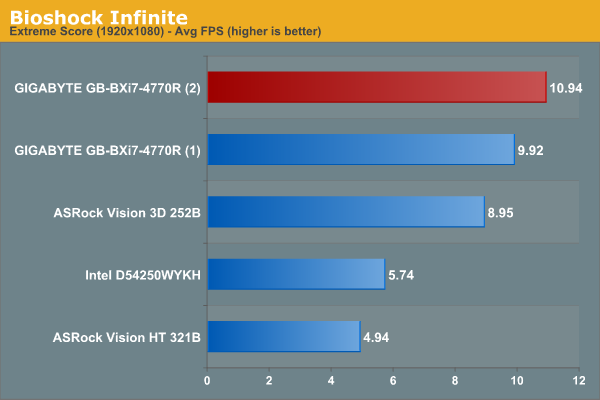
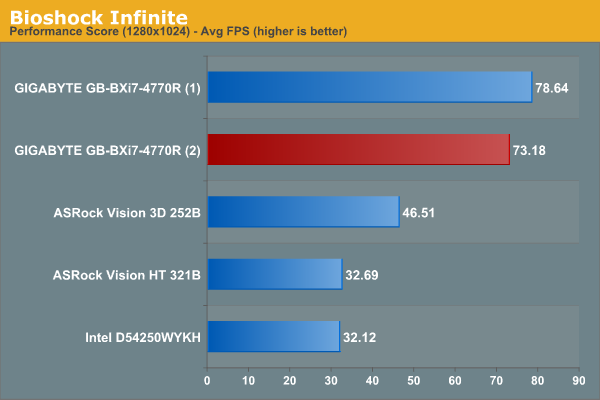
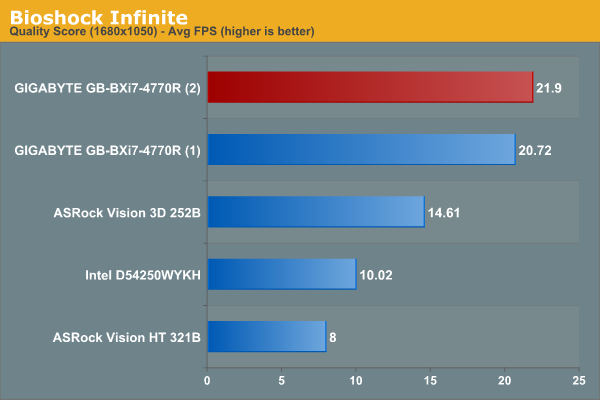
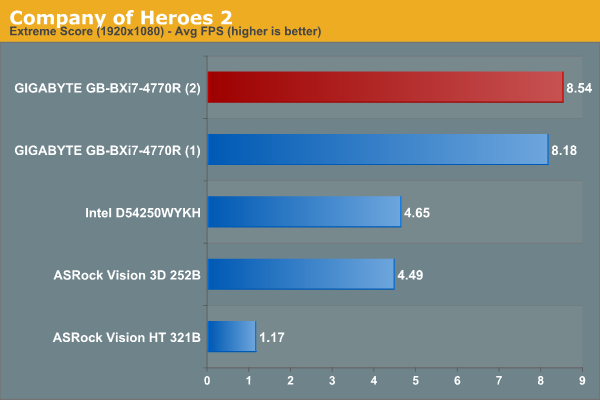
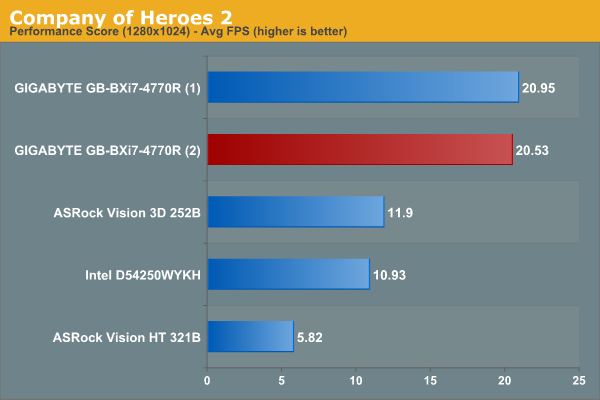
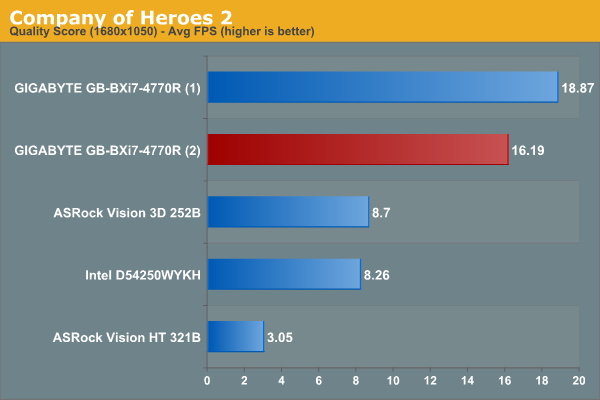
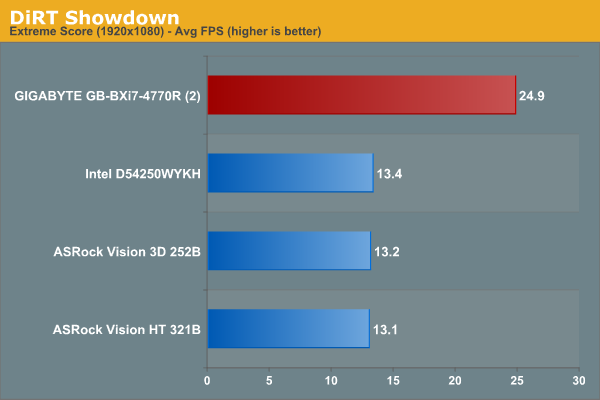
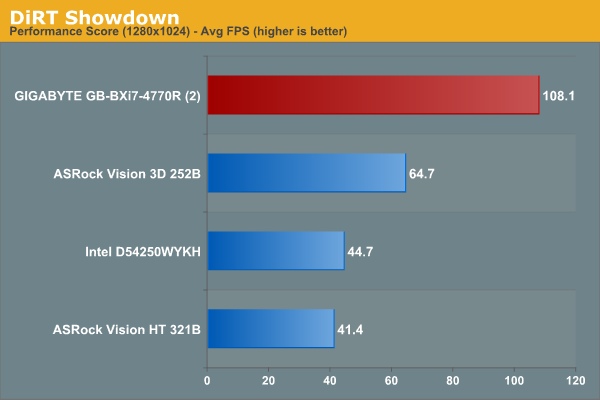
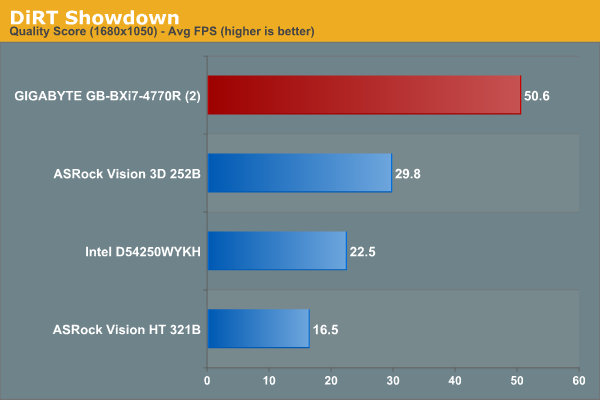
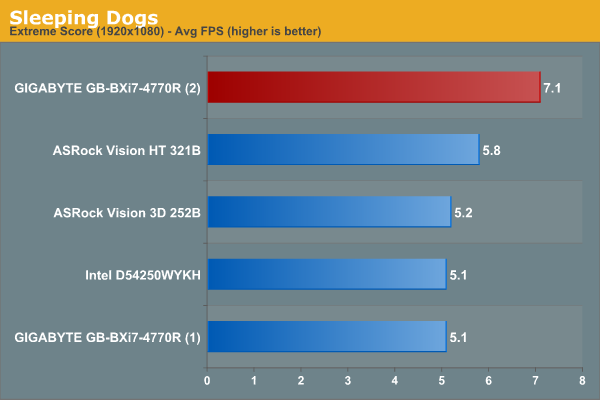
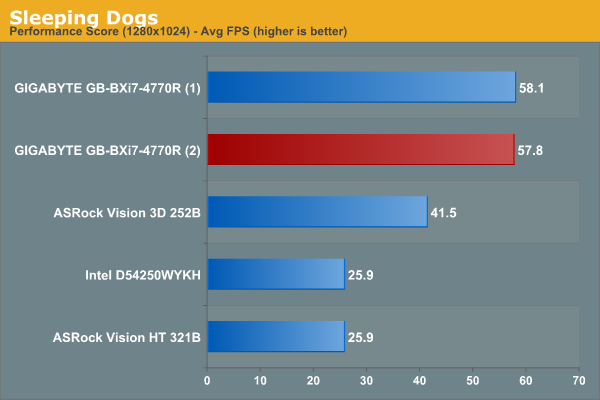
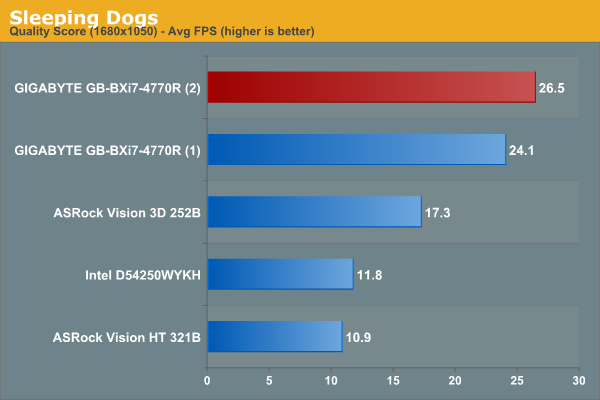
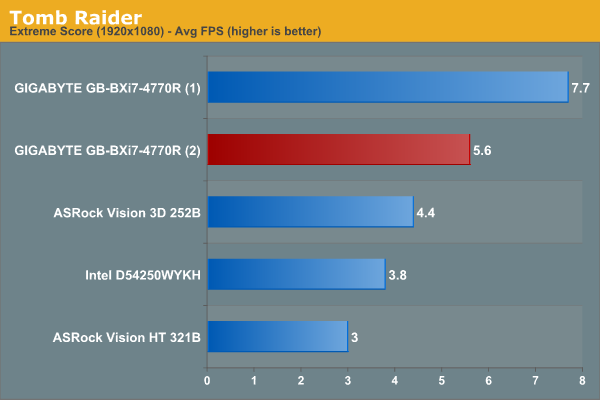
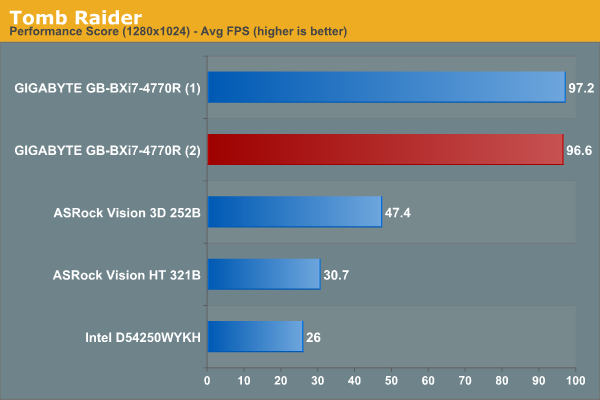
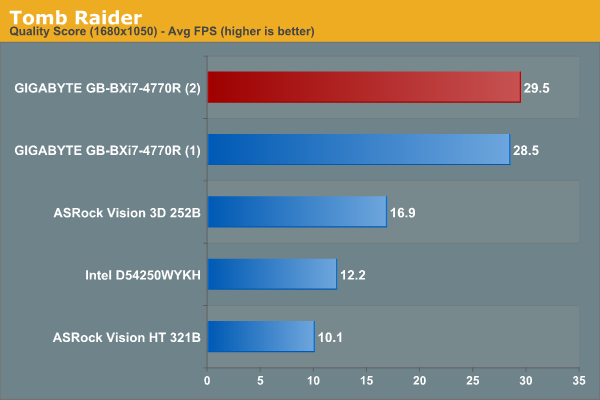
We see that the extra CPU grunt as well as the more powerful GPU clearly make the BRIX Pro stand out. Most of the games also benefit from the higher DRAM speeds (particularly at higher quality levels). The gaming credentials also outweigh that of the ASRock Vision 3D 252B, a bonafide gaming mini-PC just two generations old. However, as we shall see in the forthcoming review of the ASRock VisionX 420D, the BRIX Pro's i7-4770R is no match for a discrete mobile GPU such as the Radeon R9 M270X. Relaxing the size and power consumption requirements a bit gives an opportunity for the slightly larger VisionX 420D to deliver a better gaming performance at approximately the same cost.
Networking & Storage Performance
We have recently started devoting a separate section to analyze the storage and networking credentials of the units under review. On the storage side, one option would be repetition of our strenuous SSD review tests on the drive(s) in the PC. Fortunately, to avoid that overkill, PCMark 8 has a storage bench where certain common workloads such as loading games and document processing are replayed on the target drive. Results are presented in two forms, one being a benchmark number and the other, a bandwidth figure. We ran the PCMark 8 storage bench on selected PCs and the results are presented below. Note that this is not a reflection of the performance of the BRIX Pro by itself, but more of a validation of our choice of the storage drive for the build.
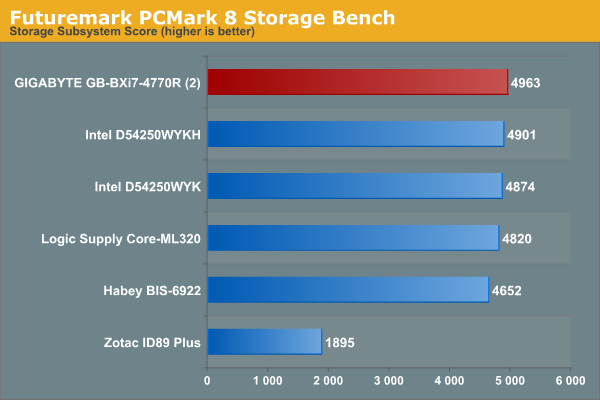
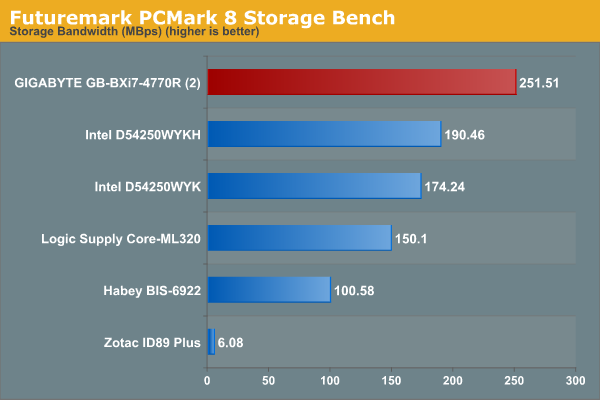
On the networking side, we restricted ourselves to the evaluation of the WLAN component. Our standard test router is the Netgear R7000 Nighthawk configured with both 2.4 GHz and 5 GHz networks. The router is placed approximately 20 ft. away, separated by a drywall (as in a typical US building). A wired client (Zotac ID89-Plus) is connected to the R7000 and serves as one endpoint for iPerf evaluation. The PC under test is made to connect to either the 5 GHz (preferred) or 2.4 GHz SSID and iPerf tests are conducted for both TCP and UDP transfers. It is ensured that the PC under test is the only wireless client for the Netgear R7000. We evaluate total throughput for up to 32 simultaneous TCP connections using iPerf and present the highest number in the graph below.
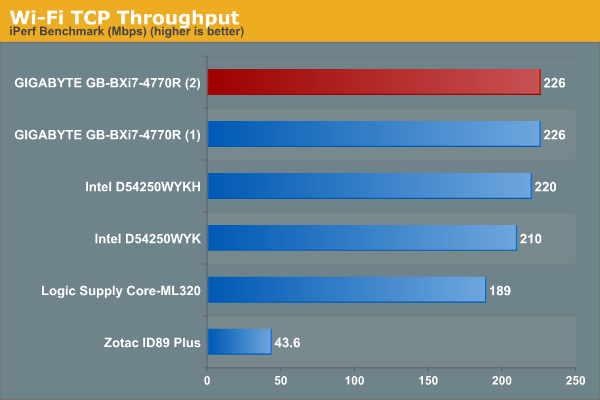
In the UDP case, we try to transfer data at the highest rate possible for which we get less than 1% packet loss.
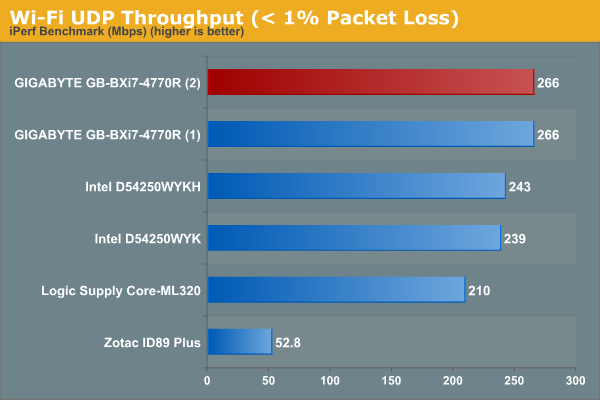
The Realtek 802.11ac module, despite being only 1T1R, surprisingly fares better than the Intel one (2T2R) when used with the Broadcom-based Netgear R7000 router.
HTPC Credentials
Accuracy of display refresh rate, efficiency while streaming OTT content and the ability to use powerful video renderers such as madVR are some of the primary points of interest in terms of HTPC usage.
Custom Refresh Rates
In our initial Haswell HTPC review, we found that Haswell provided excellent display refresh rate accuracy. Our experience with the BRIX Pro was no different.
The gallery below presents some of the other refresh rates that we tested out. madVR reports frame drops / repeats only once every 6 hours or more in the quiescent state.
While it is not easy to configure custom resolutions / refresh rates from the main UI for the graphics configuration, it is possible to set the refresh rates manually by deselecting the 'Hide Unsupported Monitor Modes' in the monitor properties. I was able to successfully drive the display at 50 Hz on the Sony KDL46EX720 using this method.
Network Streaming Efficiency
Evaluation of OTT playback efficiency was done by playing back our standard YouTube test stream and five minutes from our standard Netflix test title. Using HTML5, the YouTube stream plays back a 720p encoding, while Adobe Flash delivers a 1080p stream. The power consumption at the wall as well as the GPU usage while playing them on Mozilla Firefox are provided in the graphs below.
Netflix streaming evaluation was done using the Windows 8.1 Netflix app. Manual stream selection is available (Ctrl-Alt-Shift-S) and debug information / statistics can also be viewed (Ctrl-Alt-Shift-D). Statistics collected for the YouTube streaming experiment were also collected here.
It is a bit surprising that Flash streaming (at a higher resolution) seems to be more efficient in terms of resource usage compared to HTML5. On the Netflix front, GPU usage for the decoding of the 5.8 Mbps video stream is pretty low and power consumption is quite low given the CPU inside. However, it can't rival the efficiency of the D54250WYK NUC kits (which utilize ULV CPUs) when it comes to video decoding / streaming efficiency.
Notes on madVR
Given the better GPU available in the Core i7-4770R, it can be expected that the madVR capabilities are slightly better than what we found in the initial Haswell HTPC review. In that review, decoding and rendering benchmark numbers for madVR, as well as other renderers, were presented. Those tests were performed on a i7-4765T. The i7-4770R in the BRIX Pro has a slightly higher TDP. There should be no cause for concern as to whether the BRIX Pro can perform as well as the Haswell HTPC that we presented in our initial review with respect to those aspects.
Andrew Van Til put the BRIX Pro through some madVR tests in his MissingRemote review and came away with the conclusion that Lanczos 4-tap with anti-ringing as well as Jinc 3-tap with anti-rining work for all types of contents (resolutions / frame rates up to 1080p) except for 720p60.
On the whole, the performance of the BRIX Pro as a HTPC is as expected. However, those looking for a pure HTPC solution would do well to consider other alternatives. In our opinion, the incremental madVR capabilities are not worth the noisy cooling solution. The other aspects that the BRIX Pro excels at are easily achieved using other Haswell-based machines (including the Intel NUC).
Thermal Performance & Power Consumption
A discussion of the cooling system, fan speeds and subjective noise levels can be found in the first part of our BRIX Pro review. A couple of months back, GIGABYTE came forward with a new BIOS for the BRIX Pro. After installing that, we repeated our extreme power virus test of running Prime 95 and Furmark together at the same time. As expected, the system did throttle within two minutes of starting the test (as shown in the screenshot below).
I am yet to see a system equipped with a Core i7-4770R that has been able to keep up with the CPU and GPU being loaded up simultaneously, and manufacturers contend that it is hardly a realistic use-case. While we tend to agree to a limited extent, we felt it would be worthy of further evaluation. Towards this, we kicked off a run with only Prime 95 loading up all the CPU threads.
After 30 minutes of full CPU loading, we found that the core temperatures were held below 100 C, the clock speeds remained at 3.2 GHz for the CPU (the GPU was 'idling' at 200 MHz) and there was no thermal throttling to be seen. At this point, we introduced Furmark loading into the picture. It becomes clear that the system gives preference to CPU performance. The GPU remains throttled at 200 MHz, while the CPU cores don't thermally throttle.
This is quite a relief, as there are probably no realistic workloads out there which can stress both CPU and GPU to the maximum simultaneously. To verify whether GPU performance perks up after removal of CPU load, we stopped the Prime 95 job and let Furmark continue for more time.
After more than 45 minutes, we found the GPU still clocking in at 1 GHz and running without any throttling issues. The CPU cores were idling at 800 MHz.
On the whole, thermal performance seems to have improved quite a bit with the latest BIOS release and we are actually happy to see that CPU performance just doesn't throttle as long as the GPU doesn't simultaneously ramp up with the CPU.
In terms of power consumption, we gathered the idle and load power numbers (at the wall) with the new configuration. The numbers are presented below.
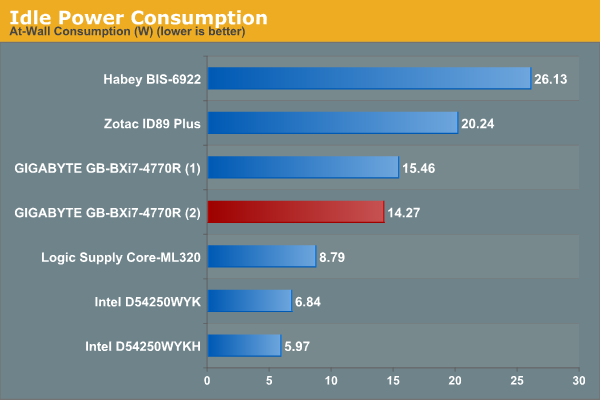
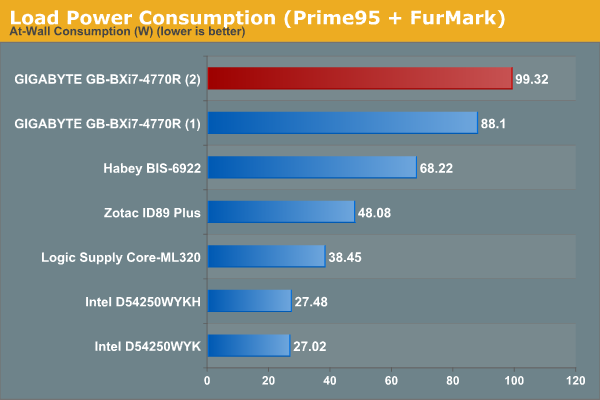
The numbers vary slightly from our initial configuration (more efficient at idle, but consumes more power at load), and I believe these related to the BIOS update as well as the memory and storage subsystem changes.
Concluding Remarks
Intel's Core i7-4770R, despite being announced along with the rest of the Haswell family, had been impossible for consumers to source throughout 2013. Earlier this year, GIGABYTE became the first to come out with a PC based on that. The fact that they managed to cram the silicon into a NUC-sized motherboard in the BRIX Pro was no mean engineering feat.
After evaluating the BRIX Pro in detail over the last six months, we can say that it will turn out to be a trendsetter for compact gaming PCs. It has already made boutique PC vendors sit up and take notice. Recently, both iBUYPOWER and CyberPowerPC introduced SFF gaming PCs which use the BRIX Pro and provide consumers with options to complete the build (and create an off-the-shelf solution). In addition, GIGABYTE has already exhibited a number of different configurations in the same form factor.
However, with great power, we end up with much noise too. We simply can't recommend the unit for users who want a quiet HTPC for madVR capabilities or casual office work. But, the unit definitely excels as a compact machine for gaming with medium quality settings. In fact, it comprehensively beats what qualified as a bonafide mini-PC targeting gamers (the ASRock Vision 3D 252B) less than a couple of years ago. The powerful CPU makes sure that extensive multi-tasking as well as heavy duty office work can be carried out without any problems (as long as the acoustics are not a matter of concern). In terms of internal components, it is good to see that the 2.5" drive support is much easier to utilize compared to the Intel D54250WYKH NUC kit. We were a bit worried about the Realtek WLAN solution being foisted on consumers, but it turns out to be a surprisingly good performer (particularly with the Broadcom-based Netgear R7000 in our testbed).
On the whole, the GIGABYTE BRIX Pro has plenty going for it. The only aspect that we would like to see addressed in future versions is the thermal solution. Even while maintaining the same motherboard size, it might be possible to go in for a larger heat sink at the cost of increasing the unit's height. This might allow for better acoustics and extract even better performance from the processor by avoiding the throttling. In our opinion, the target market (gamers) would probably not mind it.

